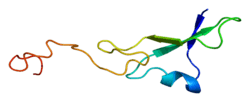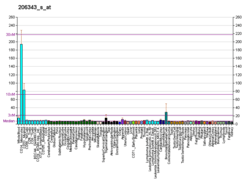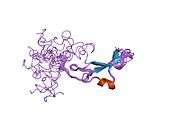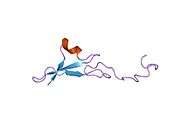Neuregulin 1
Neuregulin 1, or NRG1, is a gene of the epidermal growth factor family that in humans is encoded by the NRG1 gene.[3][4] NRG1 is one of four proteins in the neuregulin family that act on the EGFR family of receptors. Neuregulin 1 is produced in numerous isoforms by alternative splicing, which allows it to perform a wide variety of functions. It is essential for the normal development of the nervous system and the heart.[5][6]
Structure
Neuregulin 1 (NRG1) was originally identified as a 44-kD glycoprotein that interacts with the NEU/ERBB2 receptor tyrosine kinase to increase its phosphorylation on tyrosine residues. It is known that an extraordinary variety of different isoforms are produced from the NRG1 gene by alternative splicing. These isoforms include heregulins (HRGs), glial growth factors (GGFs) and sensory and motor neuron-derived factor (SMDF). They are tissue-specific and differ significantly in their structure. The HRG isoforms all contain immunoglobulin (Ig) and epidermal growth factor-like (EGF-like) domains. GGF and GGF2 isoforms contain a kringle-like sequence plus Ig and EGF-like domains; and the SMDF isoform shares only the EGF-like domain with other isoforms. The receptors for all NRG1 isoforms are the ERBB family of tyrosine kinase transmembrane receptors. Through their displayed interaction with ERBB receptors, NRG1 isoforms induce the growth and differentiation of epithelial, neuronal, glial, and other types of cells.[7]
Function
Synaptic plasticity
Neuregulin 1 is thought to play a role in synaptic plasticity. It has been shown that a loss of Neuregulin 1 within cortical projection neurons results in increased inhibitory connections and reduced synaptic plasticity.[8] Similarly, overexpression of Neuregulin 1 results in disrupted excitatory-inhibitory connections, reduced synaptic plasticity, and abnormal dendritic spine growth. Mutations in human L1 cell adhesion molecules are reported to cause a number of neuronal disorders. In addition, recent research in Drosophila model has also shown Nrg's involvement in regulating dendritic pruning in ddaC neurons in a Rab5/ESCRT-mediated endocytic pathway.[9] Thus, careful regulation of the amount of Neuregulin 1 must be maintained in order to preserve an intricate balance between excitatory and inhibitory connections within the central nervous system (CNS). Any disruption in this inhibitory system may contribute to impaired synaptic plasticity, a symptom endemic in schizophrenic patients.
Isoforms
At least six major types (different N termini) of neuregulin 1 are known.[10] Six types exist in humans and rodents (type I, II and III NRG1 are expressed in excitatory and inhibitory neurons, as well as astrocytes), and some types (I and IV) can be regulated by neuronal activity.[11]
| type | aliases |
|---|---|
| I | Heregulin, NEU differentiation factor (NDF), or acetylcholine receptor inducing activity (ARIA) |
| II | Glial Growth Factor-2 (GGF2) |
| III | Sensory and motor neuron-derived factor (SMDF) |
| IV | |
| V | |
| VI |
Clinical significance
Neuregulin 1-ErbB4 interactions are thought to play a role in the pathological mechanism of schizophrenia.[12][13] A high-risk deCODE (Icelandic) haplotype was discovered in 2002 on the 5'-end of the gene.[14] The SNP8NRG243177 allele from this haplotype was associated in 2006 with a heightened expression of the Type IV NRG1 in the brains of people suffering from schizophrenia.[15][16] Further, the NRG1-ErbB4 signalling complex has been highlighted as a potential target for new antipsychotic treatment.[17][18]
Additionally, Neuregulin 1 has been shown to modulate anxiety-like behaviors. Endogenous Neuregulin 1 may bind to its receptor, ErbB4, expressed on GABAergic neurons within the basolateral amygdala. Administration of exogenous Neuregulin 1 to the basolateral amygdala of anxious mice produced an anxiolytic effect, which has been attributed to the enhancement of GABAergic neurotransmission.[19] Thus, treatments aimed at reducing anxiety, which may contribute to emotional instability in many schizophrenic patients, by targeting the effects of mutations in NRG1 and ERBB4, may yield positive results for those afflicted by both anxiety disorders as well as schizophrenia.
Neuregulin has been shown to be involved in the myelination of central nervous system (CNS) axons.[20] There exist at least two modes of myelination within the CNS—one that is independent of neuronal activity and another that is promoted by the activation of NMDA receptors by glutamate on oligodendrocytes. Neuregulin is involved in the "switching" of oligodendrocytes from the mode of myelination that is independent of neuronal activity to the mode that is dependent upon glutamate binding to NMDA receptors. It is thought that Neuregulin 1 found on axons of CNS neurons interacts with its receptor, ErbB4, to promote the myelination of that axon, and any disruption in this signaling contributes to decreased myelination.[21] Since Neuregulin 1 promotes myelination and is decreased in schizophrenic patients, along with the finding that schizophrenic patients experience white matter deficits, mutations within Neuregulin 1 may underlie cognitive deficits associated with lower white matter integrity, especially within frontotemporal connections.
The protein also has the putative ability to protect the brain from damage induced by stroke.[22] Those with a genetic variant of neuregulin 1 tended to be more creative.[23]
There is evidence that NRG1 is a tumor suppressor gene.[24]
There is also strong evidence that NRG1 plays a critical role in Schwann cell maturation, survival, and motility,[25] important in research related to neurofibromatosis type two (NF2).
Heart
Neuregulin-1 (NRG-1), a cardioactive growth factor released from endothelial cells, is necessary for cardiac development, structural maintenance, and functional integrity of the heart. NRG-1 and its receptor family ErbB can play a beneficial role in the treatment of chronic heart failure (CHF) by promoting survival of cardiac myocytes, improving sarcomeric structure, balancing Ca2+ homeostasis, and enhancing pumping function. Downstream effectors of NRG-1/ErbB, include cardiac-specific myosin light chain kinase (cMLCK), Protein Phosphatase type 1 (PP1), sarcoplasmic reticulum Ca2+-ATPase 2 (SERCA2), and focal adhesion kinase (FAK). The beneficial effects of neuregulin-1 make recombinant human neuregulin-1 (rhNRG-1) a potential drug for treatment of CHF.[26]
Maintenance of heart structure
NRG-1 treatment of adult rat ventricular myocytes stimulate the formation of a multiprotein complex between ErbB2, FAK, and p130(CAS), which modulates the restoration of cell–cell contacts between isolated myocytes, allowing for synchronous beating.[27] Furthermore, FAK is also involved in the maintenance of sarcomeric organization, cell survival, and myocyte–myocyte interactions.[28] The sarcomeric effects of NRG-1 protects myocytes against structural disarray induced by stressors, including cytotoxic agents.[29]
Cardiomyocyte survival under stress
Under conditions of stress, including viral infection, cytotoxic agents, and oxidative stress, activation of NRG-1/ErbB signaling can protect myocardial cells against apoptosis.[27] In contrast to embryonic and neonatal cardiomyocytes, adult myocardial cells are terminally differentiated and have lost the ability to proliferate. Therefore, growth of adult cardiac cells is commonly characterized by hypertrophy and an increased content of contractile proteins.[30] However, studies have shown NRG-1 promotes myocardial regeneration through hyperplasia, and prevents hypertrophy surrounding infarcted areas.[31]
Restoration of cardiomyocytes
The cMLCK protein is an important regulator of sarcomere assembly through activation of the myosin regulatory light chain, as well as playing a role in heart contractility.[32][33] In contrast to smooth and skeletal muscle MLCKs, cMLCK expression is restricted to cardiac myocytes.[33] Overexpression of cMLCK increases cell contractility.[32] Treatment of cardiac myocytes with rhNRG-1 significantly upregulated cMLCK expression or activity??? in CHF rat models, together with an improvement in both cardiomyocyte structure and pumping function.[26] Therefore, cMLCK is a downstream protein regulated by NRG-1/ErbB signaling and plays a role in rhNRG-1-mediated improvements in CHF.
Improvements in cardiac efficiency
Altered calcium homeostasis has been suggested to play a role in the development of heart failure. Modulated by phospholamban (PLB), SERCA2 regulates uptake of Ca2+ into the sarcoplasmic reticulum (SR) from the cytoplasm and contributes to the relaxation of cardiomyocytes.[34] This process is also important for determining the SR Ca2+ load after relaxation and, thus, impacts on contractility.[34][35] PP1 dephosphorylates PLB, inhibiting SERCA2 activity.[36] In the failing heart, PP1 expression is upregulated, resulting in increased PLB dephosphorylation and decreased SERCA2 activity.[37] Preliminary studies have revealed that rhNRG-normalizes SERCA function and enhances myocardial contractility through the inhibition of increasedPP1 expression, which leads to increased PLB phosphorylation and activation of SERCA2.
Interactions
Neuregulin 1 has been shown to interact with ERBB3[38][39][40] and LIMK1.[41] A schizophrenia associated- missense mutation in Neuregulin 1 has been shown to be associated with changes in cytokine expression using lymphoblastoid cells of heterozygous carriers vs homozygous wild type individuals [42]
Specifically, the missense mutation involves a single nucleotide change of a valine to a leucine within the transmembrane domain of Type 3 Neuregulin 1. It is thought that this single nucleotide change affects the ability of γ-secretase to cleave the intracellular domain (ICD) of the Type 3 isoform of Neureglin 1.[43] That is, the valine to leucine mutation within the transmembrane domain of Type 3 Neuregulin 1 decreases the amount of ICD that γ-secretase is able to cleave. The ICD of Type 3 Neuregulin 1 has been shown to suppress transcription of inflammatory cytokines, including IL-1β, IL-6, IL-10, IL-8, IL12-p70, and TNF-α. Using recombinant ErbB4 to stimulate the cleavage of the intracellular domain of Type 3 Neuregulin 1, a receptor for Type 3 Neuregulin 1, Marballi et al. showed that increased levels of the ICD lead to a decrease in IL-6 levels. Given the involvement of Neuregulin 1 in schizophrenia and the finding that the valine to leucine missense mutation in mice produces working memory deficits,[44] NRG1 seems a likely genetic candidate that confers susceptibility to the development of schizophrenia.
References
- GRCh38: Ensembl release 89: ENSG00000157168 - Ensembl, May 2017
- "Human PubMed Reference:". National Center for Biotechnology Information, U.S. National Library of Medicine.
- Holmes WE, Sliwkowski MX, Akita RW, Henzel WJ, Lee J, Park JW, Yansura D, Abadi N, Raab H, Lewis GD (May 1992). "Identification of heregulin, a specific activator of p185erbB2". Science. 256 (5060): 1205–10. doi:10.1126/science.256.5060.1205. PMID 1350381.
- Orr-Urtreger A, Trakhtenbrot L, Ben-Levy R, Wen D, Rechavi G, Lonai P, Yarden Y (March 1993). "Neural expression and chromosomal mapping of Neu differentiation factor to 8p12-p21". Proc. Natl. Acad. Sci. U.S.A. 90 (5): 1867–71. doi:10.1073/pnas.90.5.1867. PMC 45981. PMID 8095334.
- Britsch S (2007). The neuregulin-I/ErbB signaling system in development and disease. Adv Anat Embryol Cell Biol. Advances in Anatomy Embryology and Cell Biology. 190. pp. 1–65. doi:10.1007/978-3-540-37107-6_1. ISBN 978-3-540-37105-2. PMID 17432114.
- Talmage DA (2008). Mechanisms of neuregulin action. Novartis Found. Symp. Novartis Foundation Symposia. 289. pp. 74–84, discussion 84–93. doi:10.1002/9780470751251.ch6. ISBN 9780470751251. PMC 2621364. PMID 18497096.
- "Entrez Gene: NRG1 Neuregulin 1".
- Agarwal A, Zhang M, Trembak-Duff I, Unterbarnscheidt T, Radyushkin K, Dibaj P, Martins de Souza D, Boretius S, Brzózka MM, Steffens H, Berning S, Teng Z, Gummert MN, Tantra M, Guest PC, Willig KI, Frahm J, Hell SW, Bahn S, Rossner MJ, Nave KA, Ehrenreich H, Zhang W, Schwab MH (2014). "Dysregulated expression of neuregulin-1 by cortical pyramidal neurons disrupts synaptic plasticity". Cell Reports. 8 (4): 1130–45. doi:10.1016/j.celrep.2014.07.026. PMID 25131210.
- Zhang, Heng; Wang, Yan; Wong, Jack Jing Lin; Lim, Kah-Leong; Liou, Yih-Cherng; Wang, Hongyan; Yu, Fengwei (2014-08-25). "Endocytic pathways downregulate the L1-type cell adhesion molecule neuroglian to promote dendrite pruning in Drosophila". Developmental Cell. 30 (4): 463–478. doi:10.1016/j.devcel.2014.06.014. ISSN 1878-1551. PMID 25158855.
- Steinthorsdottir V, Stefansson H, Ghosh S, Birgisdottir B, Bjornsdottir S, Fasquel AC, Olafsson O, Stefansson K, Gulcher JR (November 2004). "Multiple novel transcription initiation sites for NRG1". Gene. 342 (1): 97–105. doi:10.1016/j.gene.2004.07.029. PMID 15527969.
- Liu X, Bates R, Yin DM, Shen C, Wang F, Su N, Kirov SA, Luo Y, Wang JZ, Xiong WC, Mei L (June 2011). "Specific Regulation of NRG1 Isoform Expression by Neuronal Activity". J. Neurosci. 31 (23): 8491–501. doi:10.1523/JNEUROSCI.5317-10.2011. PMC 3154699. PMID 21653853.
- Li D, Collier DA, He L (June 2006). "Meta-analysis shows strong positive association of the neuregulin 1 (NRG1) gene with schizophrenia". Hum. Mol. Genet. 15 (12): 1995–2002. doi:10.1093/hmg/ddl122. PMID 16687441.
- Gene Overview of All Published Schizophrenia-Association Studies for NRG1 Archived 2007-09-27 at the Wayback Machine- SchizophreniaGene database, Schizophrenia Research Forum.
- Stefansson H, Sigurdsson E, Steinthorsdottir V, Bjornsdottir S, Sigmundsson T, Ghosh S, Brynjolfsson J, Gunnarsdottir S, Ivarsson O, Chou TT, Hjaltason O, Birgisdottir B, Jonsson H, Gudnadottir VG, Gudmundsdottir E, Bjornsson A, Ingvarsson B, Ingason A, Sigfusson S, Hardardottir H, Harvey RP, Lai D, Zhou M, Brunner D, Mutel V, Gonzalo A, Lemke G, Sainz J, Johannesson G, Andresson T, Gudbjartsson D, Manolescu A, Frigge ML, Gurney ME, Kong A, Gulcher JR, Petursson H, Stefansson K (October 2002). "Neuregulin 1 and susceptibility to schizophrenia". Am. J. Hum. Genet. 71 (4): 877–92. doi:10.1086/342734. PMC 378543. PMID 12145742.
- Law AJ, Lipska BK, Weickert CS, Hyde TM, Straub RE, Hashimoto R, Harrison PJ, Kleinman JE, Weinberger DR (April 2006). "Neuregulin 1 transcripts are differentially expressed in schizophrenia and regulated by 5' SNPs associated with the disease". Proc. Natl. Acad. Sci. U.S.A. 103 (17): 6747–52. doi:10.1073/pnas.0602002103. PMC 1458952. PMID 16618933.
- Hall J, Whalley HC, Job DE, Baig BJ, McIntosh AM, Evans KL, Thomson PA, Porteous DJ, Cunningham-Owens DG, Johnstone EC, Lawrie SM (December 2006). "A neuregulin 1 variant associated with abnormal cortical function and psychotic symptoms". Nat. Neurosci. 9 (12): 1477–8. doi:10.1038/nn1795. PMID 17072305.
- Deng C, Pan B, Engel M, Huang XF (February 2013). "Neuregulin-1 signalling and antipsychotic treatment : Potential therapeutic targets in a schizophrenia candidate signalling pathway". Psychopharmacology. 226 (2): 201–15. doi:10.1007/s00213-013-3003-2. PMID 23389757.
- Engel M, Snikeris P, Jenner A, Karl T, Huang X, Frank E (26 December 2014). "Neuregulin 1 prevents phencyclidine-induced behavioral impairments and disruptions to GABAergic signaling in mice". International Journal of Neuropsychopharmacology. 18 (7): pyu114. doi:10.1093/ijnp/pyu114. PMC 4540095. PMID 26478928. Retrieved 30 December 2014.
- Bi LL, Sun XD, Zhang J, Lu YS, Chen YH, Wang J, Geng F, Liu F, Zhang M, Liu JH, Li XW, Mei L, Gao TM (2014). "Amygdala NRG1-ErbB4 is Critical for the Modulation of Anxiety-Like Behaviors". Neuropsychopharmacology. 40 (4): 974–86. doi:10.1038/npp.2014.274. PMC 4330511. PMID 25308353.
- Lundgaard I, Luzhynskaya A, Stockley JH, Wang Z, Evans KA, Swire M, Volbracht K, Gautier HO, Franklin RJ, Attwell D, Káradóttir RT (2013). "Neuregulin and BDNF induce a switch to NMDA receptor-dependent myelination by oligodendrocytes". PLoS Biology. 11 (12): e1001743. doi:10.1371/journal.pbio.1001743. PMC 3876980. PMID 24391468.
- Taveggia C, Thaker P, Petrylak A, Caporaso GL, Toews A, Falls DL, Einheber S, Salzer JL (2008). "Type III neuregulin-1 promotes oligodendrocyte myelination". Glia. 56 (3): 284–93. doi:10.1002/glia.20612. PMID 18080294.
- Xu Z, Croslan DR, Harris AE, Ford GD, Ford BD (2006). "Extended therapeutic window and functional recovery after intraarterial administration of neuregulin-1 after focal ischemic stroke". J. Cereb. Blood Flow Metab. 26 (4): 527–35. doi:10.1038/sj.jcbfm.9600212. PMID 16136057.
- Kéri S (September 2009). "Genes for psychosis and creativity: a promoter polymorphism of the neuregulin 1 gene is related to creativity in people with high intellectual achievement". Psychol Sci. 20 (9): 1070–3. CiteSeerX 10.1.1.676.9620. doi:10.1111/j.1467-9280.2009.02398.x. PMID 19594860. Lay summary – The Daily Galaxy: Great Discoveries Channel.
- Chua YL, Ito Y, Pole JC, Newman S, Chin SF, Stein RC, Ellis IO, Caldas C, O'Hare MJ, Murrell A, Edwards PA (October 2009). "The NRG1 gene is frequently silenced by methylation in breast cancers and is a strong candidate for the 8p tumour suppressor gene". Oncogene. 28 (46): 4041–52. doi:10.1038/onc.2009.259. PMC 2789334. PMID 19802002.
- Freidin M, Asche S, Bargiello TA, Bennett MV, Abrams CK (March 2009). "Connexin 32 increases the proliferative response of Schwann cells to neuregulin-1 (Nrg1)". Proc. Natl. Acad. Sci. U.S.A. 106 (9): 3567–72. doi:10.1073/pnas.0813413106. PMC 2651262. PMID 19218461.
- Xu Y, Li X, Liu X, Zhou M (2010). Neuregulin-1/ErbB signaling and chronic heart failure. Adv. Pharmacol. Advances in Pharmacology. 59. pp. 31–51. doi:10.1016/S1054-3589(10)59002-1. ISBN 9780123849038. PMID 20933198.
- Kuramochi Y, Cote GM, Guo X, Lebrasseur NK, Cui L, Liao R, Sawyer DB (December 2004). "Cardiac endothelial cells regulate reactive oxygen species-induced cardiomyocyte apoptosis through neuregulin-1beta/erbB4 signaling". J. Biol. Chem. 279 (49): 51141–7. doi:10.1074/jbc.M408662200. PMID 15385548.
- Boateng SY, Lateef SS, Mosley W, Hartman TJ, Hanley L, Russell B (January 2005). "RGD and YIGSR synthetic peptides facilitate cellular adhesion identical to that of laminin and fibronectin but alter the physiology of neonatal cardiac myocytes". Am. J. Physiol., Cell Physiol. 288 (1): C30–8. doi:10.1152/ajpcell.00199.2004. PMID 15371257.
- Sawyer DB, Zuppinger C, Miller TA, Eppenberger HM, Suter TM (April 2002). "Modulation of anthracycline-induced myofibrillar disarray in rat ventricular myocytes by neuregulin-1beta and anti-erbB2: potential mechanism for trastuzumab-induced cardiotoxicity". Circulation. 105 (13): 1551–4. doi:10.1161/01.CIR.0000013839.41224.1C. PMID 11927521.
- Chien KR, Knowlton KU, Zhu H, Chien S (December 1991). "Regulation of cardiac gene expression during myocardial growth and hypertrophy: molecular studies of an adaptive physiologic response". FASEB J. 5 (15): 3037–46. doi:10.1096/fasebj.5.15.1835945. PMID 1835945.
- Bersell K, Arab S, Haring B, Kühn B (July 2009). "Neuregulin1/ErbB4 signaling induces cardiomyocyte proliferation and repair of heart injury". Cell. 138 (2): 257–70. doi:10.1016/j.cell.2009.04.060. PMID 19632177.
- Chan JY, Takeda M, Briggs LE, Graham ML, Lu JT, Horikoshi N, Weinberg EO, Aoki H, Sato N, Chien KR, Kasahara H (March 2008). "Identification of cardiac-specific myosin light chain kinase". Circ. Res. 102 (5): 571–80. doi:10.1161/CIRCRESAHA.107.161687. PMC 2504503. PMID 18202317.
- Seguchi O, Takashima S, Yamazaki S, Asakura M, Asano Y, Shintani Y, Wakeno M, Minamino T, Kondo H, Furukawa H, Nakamaru K, Naito A, Takahashi T, Ohtsuka T, Kawakami K, Isomura T, Kitamura S, Tomoike H, Mochizuki N, Kitakaze M (October 2007). "A cardiac myosin light chain kinase regulates sarcomere assembly in the vertebrate heart". J. Clin. Invest. 117 (10): 2812–24. doi:10.1172/JCI30804. PMC 1978424. PMID 17885681.
- Bassani JW, Yuan W, Bers DM (May 1995). "Fractional SR Ca release is regulated by trigger Ca and SR Ca content in cardiac myocytes". Am. J. Physiol. 268 (5 Pt 1): C1313–9. doi:10.1152/ajpcell.1995.268.5.C1313. PMID 7762626.
- Verboomen H, Wuytack F, De Smedt H, Himpens B, Casteels R (September 1992). "Functional difference between SERCA2a and SERCA2b Ca2+ pumps and their modulation by phospholamban". Biochem. J. 286 (Pt 2): 591–5. doi:10.1042/bj2860591. PMC 1132938. PMID 1326945.
- MacDougall LK, Jones LR, Cohen P (March 1991). "Identification of the major protein phosphatases in mammalian cardiac muscle which dephosphorylate phospholamban". Eur. J. Biochem. 196 (3): 725–34. doi:10.1111/j.1432-1033.1991.tb15871.x. PMID 1849481.
- El-Armouche A, Rau T, Zolk O, Ditz D, Pamminger T, Zimmermann WH, Jäckel E, Harding SE, Boknik P, Neumann J, Eschenhagen T (March 2003). "Evidence for protein phosphatase inhibitor-1 playing an amplifier role in beta-adrenergic signaling in cardiac myocytes". FASEB J. 17 (3): 437–9. doi:10.1096/fj.02-0057fje. PMID 12514122.
- Singer E, Landgraf R, Horan T, Slamon D, Eisenberg D (November 2001). "Identification of a heregulin binding site in HER3 extracellular domain". J. Biol. Chem. 276 (47): 44266–74. doi:10.1074/jbc.M105428200. PMID 11555649.
- Horan T, Wen J, Arakawa T, Liu N, Brankow D, Hu S, Ratzkin B, Philo JS (October 1995). "Binding of Neu differentiation factor with the extracellular domain of Her2 and Her3". J. Biol. Chem. 270 (41): 24604–8. doi:10.1074/jbc.270.41.24604. PMID 7592681.
- Carraway KL, Weber JL, Unger MJ, Ledesma J, Yu N, Gassmann M, Lai C (May 1997). "Neuregulin-2, a new ligand of ErbB3/ErbB4-receptor tyrosine kinases". Nature. 387 (6632): 512–6. doi:10.1038/387512a0. PMID 9168115.
- Wang JY, Frenzel KE, Wen D, Falls DL (August 1998). "Transmembrane neuregulins interact with LIM kinase 1, a cytoplasmic protein kinase implicated in development of visuospatial cognition". J. Biol. Chem. 273 (32): 20525–34. doi:10.1074/jbc.273.32.20525. PMID 9685409.
- Marballi K, Quinones MP, Jimenez F, Escamilla MA, Raventós H, Soto-Bernardini MC, Ahuja SS, Walss-Bass C (November 2010). "In vivo and in vitro genetic evidence of involvement of neuregulin 1 in immune system dysregulation". Journal of Molecular Medicine. 88 (11): 1133–41. doi:10.1007/s00109-010-0653-y. PMC 2976656. PMID 20625696.
- Marballi K, Quinones MP, Jimenez F, Escamilla MA, Raventós H, Soto-Bernardini MC, Ahuja SS, Walss-Bass C (2010). "In vivo and in vitro genetic evidence of involvement of neuregulin 1 in immune system dysregulation". Journal of Molecular Medicine. 88 (11): 1133–41. doi:10.1007/s00109-010-0653-y. PMC 2976656. PMID 20625696.
- Dejaegere T, Serneels L, Schäfer MK, Van Biervliet J, Horré K, Depboylu C, Alvarez-Fischer D, Herreman A, Willem M, Haass C, Höglinger GU, D'Hooge R, De Strooper B (2008). "Deficiency of Aph1B/C-gamma-secretase disturbs Nrg1 cleavage and sensorimotor gating that can be reversed with antipsychotic treatment". Proceedings of the National Academy of Sciences. 105 (28): 9775–80. doi:10.1073/pnas.0800507105. PMC 2474502. PMID 18626010.
Further reading
- Birchmeier C, Nave KA (Sep 2008). "(Review) Neuregulin-1, a key axonal signal that drives Schwann cell growth and differentiation". Glia. 56 (14): 1491–1497. doi:10.1002/glia.20753. PMID 18803318.
- Lupu R, Lippman ME (1994). "William L. McGuire Memorial Symposium. The role of erbB2 signal transduction pathways in human breast cancer". Breast Cancer Res. Treat. 27 (1–2): 83–93. doi:10.1007/BF00683195. PMID 7903175.
- Corfas G, Roy K, Buxbaum JD (2004). "Neuregulin 1-erbB signaling and the molecular/cellular basis of schizophrenia". Nat. Neurosci. 7 (6): 575–80. doi:10.1038/nn1258. PMID 15162166.
- Harrison PJ, Law AJ (2006). "Neuregulin 1 and schizophrenia: genetics, gene expression, and neurobiology". Biol. Psychiatry. 60 (2): 132–40. doi:10.1016/j.biopsych.2005.11.002. PMID 16442083.
- Munafò MR, Thiselton DL, Clark TG, Flint J (2006). "Association of the NRG1 gene and schizophrenia: a meta-analysis". Mol. Psychiatry. 11 (6): 539–46. doi:10.1038/sj.mp.4001817. PMID 16520822.
External links
- Neuregulin-1 at the US National Library of Medicine Medical Subject Headings (MeSH)
- 'New way' to repair heart damage
- NRG1 rs3924999, hypothetical major gene locus of general intelligence
- Links from Schizophrenia Research Forum:
- Neuregulin, ErbB4—Levels Normal but Signaling Strengthened in Schizophrenia - 18 June 2006.
- Neuregulin and ErbB4 Mutant Mice Reveal Myelin and Synaptic Deficits - 2 May 2007.
- Functional Neuregulin Variant Linked to Psychosis, Abnormal Brain Activation and IQ - 30 October 2006.
- Neuregulin, ErbB4 Drive Developmental Cell Fates
- Neuregulin Partner ErbB4 Spices Up Genetic Associations - 17 February 2005
- Polymorphisms and Schizophrenia—The Ups and Downs of Neuregulin Expression - 21 April 2006.
- Neuregulin Studies Suggest Synaptic Deficits in Schizophrenia - 4 June 2007
This article incorporates text from the United States National Library of Medicine, which is in the public domain.







